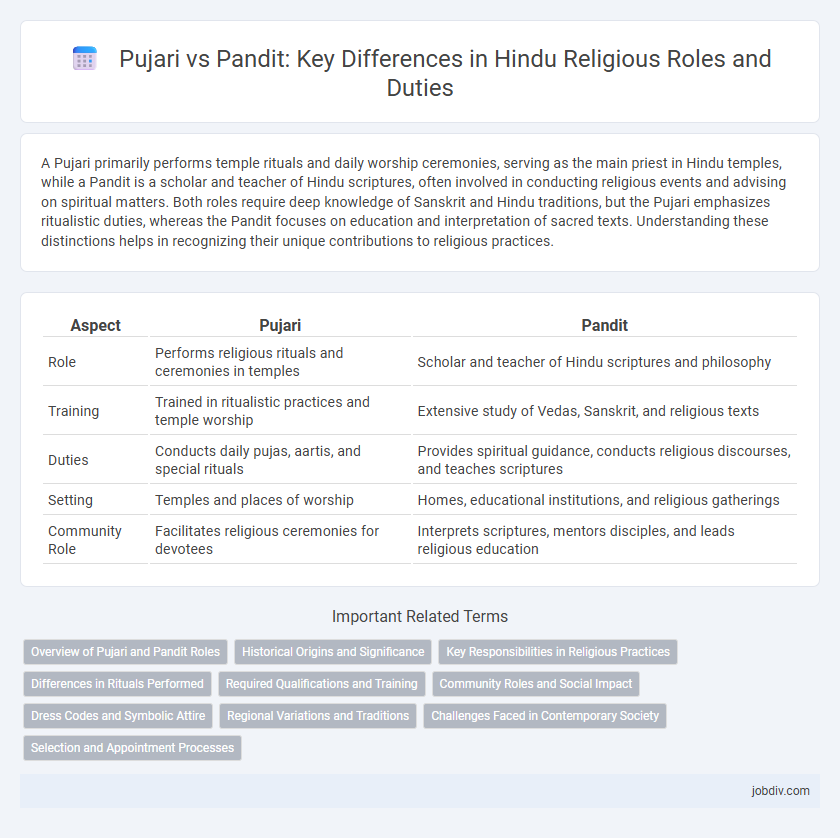A Pujari primarily performs temple rituals and daily worship ceremonies, serving as the main priest in Hindu temples, while a Pandit is a scholar and teacher of Hindu scriptures, often involved in conducting religious events and advising on spiritual matters. Both roles require deep knowledge of Sanskrit and Hindu traditions, but the Pujari emphasizes ritualistic duties, whereas the Pandit focuses on education and interpretation of sacred texts. Understanding these distinctions helps in recognizing their unique contributions to religious practices.
Table of Comparison
| Aspect | Pujari | Pandit |
|---|---|---|
| Role | Performs religious rituals and ceremonies in temples | Scholar and teacher of Hindu scriptures and philosophy |
| Training | Trained in ritualistic practices and temple worship | Extensive study of Vedas, Sanskrit, and religious texts |
| Duties | Conducts daily pujas, aartis, and special rituals | Provides spiritual guidance, conducts religious discourses, and teaches scriptures |
| Setting | Temples and places of worship | Homes, educational institutions, and religious gatherings |
| Community Role | Facilitates religious ceremonies for devotees | Interprets scriptures, mentors disciples, and leads religious education |
Overview of Pujari and Pandit Roles
Pujaris and Pandits both play vital roles in Hindu religious practices but serve distinct functions; a Pujari primarily conducts temple rituals and ceremonies, managing daily worship and offerings to deities. Pandits possess deep scholarly knowledge of Hindu scriptures like the Vedas and perform rituals requiring specialized expertise, such as weddings and astrological ceremonies. Both roles uphold spiritual traditions, with Pujaris focusing on temple services while Pandits often act as sacerdotal advisors and ritual specialists.
Historical Origins and Significance
The terms "Pujari" and "Pandit" originate from ancient Indian religious traditions, where Pujaris primarily serve as temple priests performing rituals and offerings, while Pandits are scholars who specialize in Vedic scriptures and philosophy. Historically, Pujaris have been custodians of temple worship, maintaining ritual purity and conducting ceremonies, whereas Pandits have preserved and interpreted sacred texts, guiding spiritual knowledge and education. Their significance lies in their complementary roles: Pujaris uphold devotional practices, and Pandits ensure the continuity of scriptural wisdom within Hinduism.
Key Responsibilities in Religious Practices
Pujaris primarily perform ritualistic ceremonies and daily worship in Hindu temples, ensuring the sanctity of idols and sacred spaces is maintained. Pandits specialize in conducting complex Vedic rituals, interpreting scriptures, and guiding devotees through religious ceremonies such as weddings and festivals. Both roles are integral to preserving and propelling Hindu spiritual traditions through precise execution of religious duties.
Differences in Rituals Performed
Pujaris primarily conduct temple rituals such as daily aarti, abhishek, and consecration ceremonies, focusing on maintaining temple sanctity and deity worship. Pandits often perform a wider range of rites, including complex life ceremonies like weddings, thread ceremonies (Upanayana), and Vedic chanting for various samskaras outside the temple setting. The ritual differences highlight Pujaris' emphasis on temple worship, whereas Pandits engage extensively in personalized domestic and community religious functions.
Required Qualifications and Training
Pujaris are traditionally required to have formal training in temple rituals, Vedic chants, and daily worship practices, often learned through apprenticeships at temples or gurukuls. Pandits typically possess advanced knowledge of Sanskrit scriptures, Hindu philosophy, and classical texts, often acquired through formal education and years of study under a guru. While both roles demand deep religious knowledge, Pandits are usually scholars focused on scriptural interpretation, whereas Pujaris specialize in conducting ritualistic ceremonies.
Community Roles and Social Impact
Pujaris serve primarily as temple priests responsible for performing daily rituals and maintaining the sanctity of the shrine, deeply influencing local religious practices and community cohesion. Pandits, often scholars and teachers, play a broader role by interpreting scriptures, guiding spiritual education, and shaping theological discourse, thereby impacting social values and cultural preservation. Both roles reinforce community identity but differ in their focal points: Pujaris emphasize ritualistic continuity, whereas Pandits foster intellectual and doctrinal understanding.
Dress Codes and Symbolic Attire
Pujaris typically wear traditional dhotis and kurtas in white or saffron, symbolizing purity and devotion, often accompanied by sacred threads and tilak marks on the forehead. Pandits also don similar attire but may include specific shawls or angavastras with intricate embroidery reflecting their scholarly status and ritual significance. Both dress codes emphasize spiritual symbolism, with garments and accessories chosen to honor religious customs and denote their respective roles within Hindu ceremonies.
Regional Variations and Traditions
Pujari and Pandit roles vary significantly across India's regions, with Pujaris primarily conducting temple rituals in South India, while Pandits often perform Vedic ceremonies and personal rites in North India. Regional traditions influence their religious duties, attire, and languages used during worship, reflecting diverse cultural practices within Hinduism. Distinct community expectations and scriptural interpretations shape how Pujaris and Pandits engage with devotees and maintain spiritual customs.
Challenges Faced in Contemporary Society
Pujaris often face challenges related to preserving traditional rituals amid rapidly changing societal values and technological advancements. Pandits encounter difficulties in maintaining relevance as younger generations seek more accessible spiritual guidance beyond orthodox practices. Both roles struggle with balancing authenticity with modernization to engage diverse, evolving communities.
Selection and Appointment Processes
Selection and appointment of a Pujari typically involve community consensus and hereditary factors within temple traditions, emphasizing ritual expertise and local customs. Pandits are usually appointed based on advanced scholarly qualifications in Vedic scriptures and astrology, often requiring formal education and authentication by recognized religious institutions. Both roles demand rigorous adherence to dharma and regular training, but Pandit selection leans more towards scholastic meritocracy while Pujari appointment focuses on practical ritual proficiency.
Pujari vs Pandit Infographic

 jobdiv.com
jobdiv.com